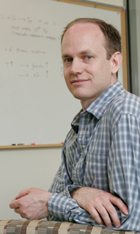Commentary: John Beacom
 |
|
Photo courtesy of The Ohio State University |
Family business
A fact of life for aspiring physicists is that others won't get to know who you are by reading your papers–they'll read your papers if they know who you are. In a global field, keeping up with all the literature is impossible: there are several dozen new papers daily on the arXiv.org server. Personal contact is essential, and I always urge students and postdocs to go to meetings and talk to strangers.
I must know several hundred other physicists worldwide well enough to talk comfortably without reintroduction, and that's not unusual. But this is hardly everyone, and so how do we fill in the gaps in our knowledge of other people? With a cultural construction that makes "six degrees of separation" look simple. Physicists keep track of a vast, intricate, and changing web of connections between the living and the dead, and it will be on the final exam.
Mathematicians have a well-documented genealogy based on their PhD advisor, and their advisor's advisor, and so on through the begats until Gauss or some other heroic figure.
A partial physics family tree is given in SPIRES HEPNAMES. Community input is welcomed. We all know who our PhD "father," "grandfather," and siblings are. (Nowadays, these families are finally including more women.)
Connections accelerate identification. Physics is a meritocracy, but these connections can provide the opportunity to be judged on merits. At Fermilab, I organized our annual astrophysics postdoc search and read more than a thousand letters of reference, mostly about applicants we hadn't met. At first, the letters sound equally good–but some are more equal than others. Letters have to be carefully calibrated according to who's writing, what they wrote in previous years (is every student the "best ever"?), and how they compare the applicants to their peers and predecessors.
But these family ties have a deeper meaning, too, since no one can learn to do physics research in isolation. Methods of thinking and judgment take years to learn by example. Students of the same mentor, even if separated in time, will bear a family resemblance in style. Physics families are extended and complicated, and each postdoc position brings new mentors, and more siblings and cousins. It's not quite like mafia families: one can gain membership in one family without losing it in another (well, usually).
In May, we had a gathering of former postdocs and students of the Fermilab Theoretical Astrophysics Group. Will Kinney, now a faculty member at SUNY Buffalo, initiated the reunion and organized it with Scott Dodelson, the current head of the group. It was much like other family reunions: seeing familiar faces again, finally meeting people I'd only heard about, and telling stories about our eccentric relatives. The group was founded in 1983 by the godfathers David Schramm and Leon Lederman, who gave the young Rocky Kolb and Mike Turner the freedom and responsibility to build the group into the international institution it is today.
A common reunion theme was that everyone greatly appreciated how they'd similarly been given the freedom to develop their own research while being challenged to perform at the highest level. Many of us had never met, and are working on very different things, but our perspectives on research and what we learned in the group were remarkably similar. While we ended the day with a trivia game (questions like "How many of the 1000+ papers written by the group had 'inflation' in the title?"–about 100), there was a lot of serious business. This included discussing ongoing projects in detail, and seeding new collaborations with invitations to visit and give seminar talks.
Even the most technical physics projects depend on personal interactions to spark new ideas and make the work more fun. The web and email facilitate connections, but there's still nothing like being there, as long as you don't have to sit at the kids' table.
John Beacom, the first David N. Schramm Fellow at Fermilab (20002004), is a faculty member in Physics and Astronomy at The Ohio State University in Columbus, Ohio. Among his primary mentors, he counts Rocky Kolb, Mike Turner, Petr Vogel, Steve Koonin, Baha Balantekin, and Adrian Melott, along with many aunts and uncles, meaning that he has a lot of physics cousins. Information on the Fermilab Theoretical Astrophysics reunion is available online.
Click here to download the pdf version of this article.


